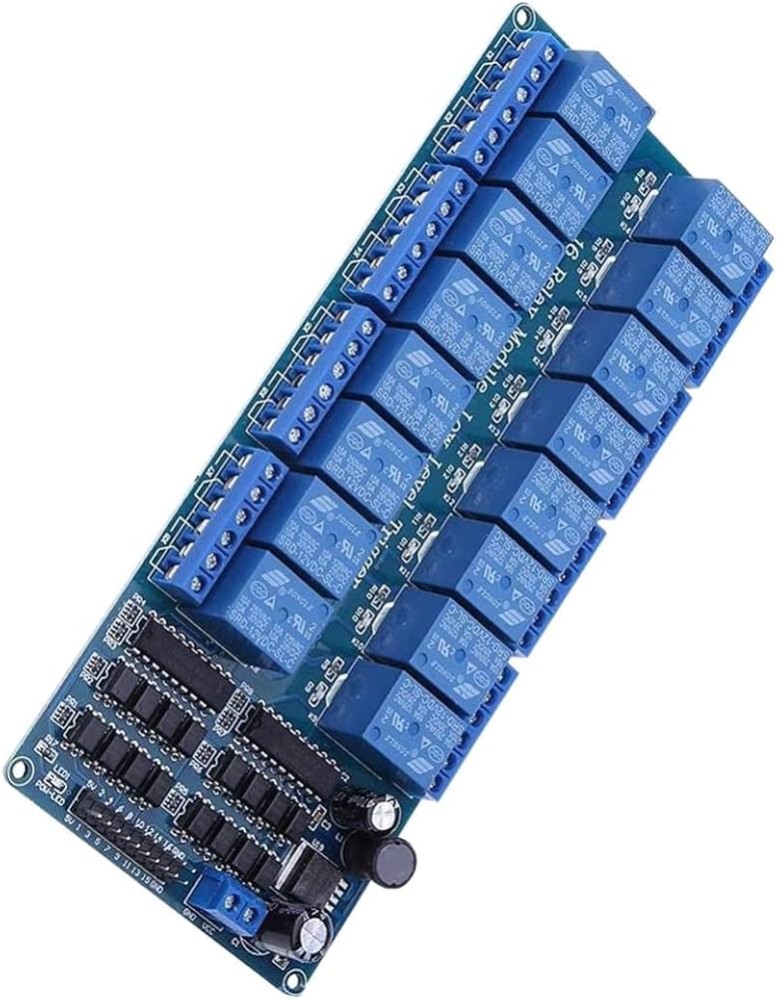





12V 16CH RELAY MODULE
This is 12V 16-Channel Relay interface board and each one of the individual relays needs 15-20mA Driver Current. The board features indication LED for Relay output status and the standard interface that can be controlled directly by many of widely used microcontrollers like Arduino etc.
₹ 588 ₹799
799



| Made In : | India |
Add FAQ
A 12V 16-Channel Relay Module is a highly versatile component designed for controlling a large number of high-power devices or systems using a low-voltage control signal. This module is ideal for applications requiring multiple relay channels, such as complex automation systems, industrial control, and advanced home automation setups.
Key Features:
-
Number of Channels:
- 16 Channels: Allows for the independent control of up to sixteen devices or systems.
-
Operating Voltage:
- 12V DC: The relay module operates on a 12V power supply, which is used to energize the relay coils.
-
Relay Type:
- Electromechanical Relays: Uses electromechanical relays to switch high-voltage AC or DC loads.
-
Relay Ratings:
- AC Load: Typically rated for 250V AC at 10A.
- DC Load: Typically rated for 30V DC at 10A.
- Note: Verify specific ratings from the relay's datasheet for accurate details.
-
Control Signal:
- 5V TTL Compatible: Controlled by a 5V TTL (Transistor-Transistor Logic) signal from a microcontroller such as Arduino, Raspberry Pi, or other similar devices.
-
Isolation:
- Optical Isolation: Includes optocouplers to provide electrical isolation between the low-voltage control side and the high-voltage load side, ensuring safety and protecting the control circuitry from high-voltage spikes.
-
Indicator LEDs:
- LED Indicators: Each relay channel usually has an onboard LED that lights up when the relay is activated, offering visual feedback on the relay's status.
-
Relay Pins:
- VCC: Power supply pin (12V DC) for energizing the relay coils.
- GND: Ground pin for the relay module.
- IN1 to IN16: Control pins for each of the sixteen relays. These pins receive 5V TTL signals to activate the relays.
- NO (Normally Open): Relay contact that closes when the relay is activated.
- NC (Normally Closed): Relay contact that opens when the relay is activated.
- COM (Common): Common terminal for each relay.
Applications:
- Home Automation: Control a large number of household appliances such as lights, fans, and other devices.
- Industrial Control: Manage multiple industrial equipment or machinery.
- Power Management: Switch power to several devices in experimental setups or prototypes.
- Automated Systems: Integrate into complex systems requiring multiple relay switches for different operational states.
Example Connection with Arduino:
To connect and control a 12V 16-Channel Relay Module with an Arduino, follow these steps:
Wiring Instructions:
-
Relay Module to Arduino:
- VCC (Relay Module) to 5V (Arduino) (Some modules may require a separate 12V power supply for the relays).
- GND (Relay Module) to GND (Arduino).
- IN1 to IN16 (Relay Control Pins) to Digital Pins 2 to 17 (Arduino) (or any available pins depending on the Arduino model and available pins).
-
Load Connection:
- NO (Relay) to one terminal of the load.
- COM (Relay) to the power source (AC or DC).
- Other terminal of the load to the ground or neutral of the power supply.
- Repeat for each relay channel as needed.
0 Reviews For this Product


.jpg&width=225&quality=80)

.jpg&width=225&quality=80)








